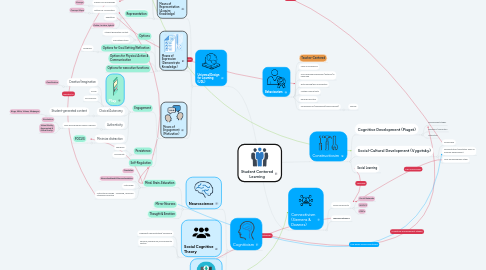
1. Universal Design for Learning (UDL)
1.1. Means of Representation (Acquire Knowledge)
1.1.1. Percpetion
1.1.1.1. Multi-modal
1.1.1.2. Customize Display of Information
1.1.2. Language
1.1.2.1. Syntax, Schema
1.1.2.2. Symbols, graphics, media
1.1.3. Representation
1.1.3.1. Assess Prior Knowledge
1.1.3.1.1. Surveys
1.1.3.2. Patterns & Visualization
1.1.3.2.1. Concept Maps
1.1.3.3. Repetition
1.1.3.4. Online, in-class, hybrid
1.2. Means of Expression (Demonstrate Knowledge)
1.2.1. Options
1.2.1.1. Student generated content
1.2.1.2. Educational tools
1.2.2. Options for Goal Setting/Reflection
1.2.2.1. Feedback
1.2.3. Options for Physical Action & Communication
1.2.4. Options for executive functions
1.3. Means of Engagement (Motivation)
1.3.1. Engagement
1.3.1.1. Play
1.3.1.1.1. Creative/Imagination
1.3.1.1.2. Social
1.3.1.1.3. Self-efficacy
1.3.1.2. Choice/Autonomy
1.3.1.2.1. Student-generated content
1.3.1.3. Authenticity
1.3.1.3.1. Real-world problem-based learning
1.3.1.4. Minimize distraction
1.3.1.4.1. FOCUS
1.3.2. Persistence
1.3.2.1. Feedback
1.3.2.2. Community
1.3.3. Self-Regulation
2. Cognitivism
2.1. Neuroscience
2.1.1. Mind, Brain, Education
2.1.1.1. Simulation
2.1.1.2. Neurofeedback & Neurostimulation
2.1.1.3. Mutlimodal
2.1.1.4. Instructional Design - Chunking, Spaced & Interleaved Practice
2.1.2. Mirror Neurons
2.1.3. Thought & Emotion
2.2. Social Cognitive Theory
2.2.1. Modeling/ Demonstrating/ Observing
2.2.2. Personal, Behavioural, Environmental Factors
2.3. Cognitive Information Processing
2.3.1. Rumelhart and McClelland- Connections and Information Storage
3. Connectivism (Siemens & Downes)
3.1. Online community
3.1.1. Social Networks
3.1.2. MOOCS
3.1.3. OER's
3.2. Learning networks
4. Constructivsim
4.1. Cognitive Development (Piaget)
4.1.1. Development stages
4.1.2. Feedback / Reflection
4.1.3. Interaction
4.2. Social-Cultural Development (Vygotsky)
4.2.1. Scaffolding
4.2.2. Demonstration/Facilitation Zone of Proximal Development
4.2.3. More Knowledgeable Other
4.3. Social Learning
5. Behaviourism
5.1. Teacher-Centered
5.2. Mind as a black box
5.3. Only observable behaviour (external) is measured
5.4. Rote learning/drill and practise
5.5. Multiple choice tests
5.6. excludes emotion
5.7. Consequences (Punishment/reinforcement)
5.7.1. Skinner
